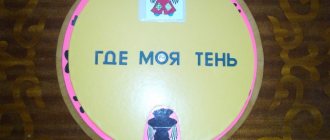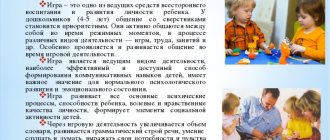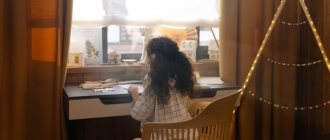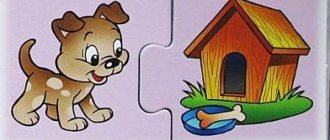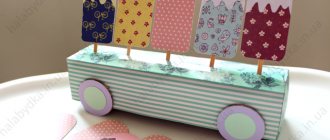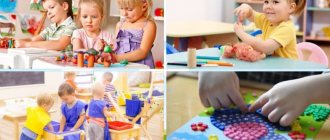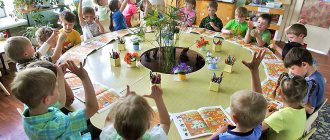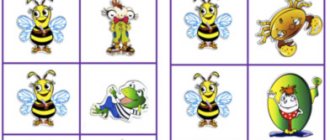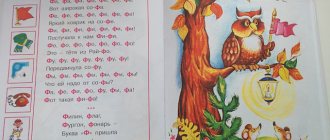Didactic games for children 6-7 years old. Card index
Card index of didactic games TRIZ and RTV (preparatory group).
Our kindergarten operates using TRIZ technologies.
Teachers systematically develop their didactic games using TRIZ technologies. I would like to present to you my developed games. Game “Let's build a kindergarten” Goal. Introduce children to a systematic approach to the world around them (component and functional). Show the dependence of the object on the place of residence. Brainstorming - built a kindergarten in the water, in the mountain. Discuss work and life in this kindergarten. For clarity, use group resources. For example: mountain - cubes, basket, blanket. Sea - aquarium - jar - box. Game “Parts - Whole” on the theme of kindergarten. Target. Introduce children to the focal object method, explaining to children the technology of working with this method. Learn to change familiar objects (or part of an object), constructing completely new ones from them. Thinking through their functions, their relationship with surrounding objects and people. Conduct a small analysis of the positive and negative in our kindergarten, in the group. Offer to come up with a completely new kindergarten, explaining how to use the focal object method. For example: in kindergarten there are different groups - glass, prickly, fabric... Think over the functions of these groups. Question: - What can you use the walls for in a group, dressing room, if they...? Part of the wall is barbed, part...? What can this wall be used for? Part of the ceiling, part of the floor...? Furniture, benefits...? Think about what you can use in a group to make a model of such a kindergarten for dolls. Use group resources. Target. Determine the main function of a kindergarten for children, for adults working in a kindergarten, for parents. Add a new row to the morphological table - kindergarten employees. Game "Why?" Why do children need kindergarten? Parents? Teachers? Other employees? The city needs a kindergarten, children? Work on the morphological table, identifying possible changes and situations with a certain choice of cards. Complication. Conduct a comparative analysis of kindergartens for children and kindergartens for animals. Name them, look at the illustrations: incubator, poultry farm, calf farm. "Kindergarten" for penguins and ducklings. Compare what birds and animals teach their children in our kindergartens. Question: Why do they teach this? A fantastic situation: a child ended up in a “kindergarten” of penguins, ducklings, and calves. Game “Fairy-tale characters in kindergarten” Goal. Introduce children to the Ring of Lull. Learn to generalize phenomena that do not have obvious connections. Learn to imagine an event in the sequence of its development, to establish relationships between individual events. Offer the children a fantastic situation: all the adults in the kindergarten went on vacation, and instead of themselves they left fairy-tale characters, very similar to themselves in everything. Question: - Who in the group will be the teacher for...? Who will be the assistant teacher? Children name heroes of fairy tales and cartoons who will work in kindergarten instead of employees. A discussion is required - why this particular hero will be instead of adults? Analysis: Question: - What is better and what is worse if in the group there is not a teacher, but, for example, Vasilisa the Beautiful. Who is better and who is worse? Show the children a sample (incomplete) of Lull's ring. Offer to make one for your group and play with it. Children can draw, write or stick images on the sectors of the rings themselves. 1 ring - heroes of fairy tales. 2 ring - kindergarten employees. 3rd ring - kindergarten premises. Play around the ring, considering each option - the sequence of events, the consequences of this change for the hero himself and those around him. Target. Teach children to set an ultimate goal, approach it, planning a sequence of actions. Strengthen the ability to use symbolic analogy. Show the dependence of the system on the environment. Game “Words are partners”. The teacher names the word, and the children find two words - a partner, which show the sequence of actions on the topic “Plant World”. For example: Lilac - vase - flowers. Grain - flour-bun. Planted - grew - collected. Game "Chain of Goals". What goal do you set for yourself... washing, eating, planting potatoes, picking berries, apples. Reveal the sequence of any action of children, breaking it down into many small goals, in the correct sequence. To go into the forest to pick mushrooms you need to: get out of bed, get dressed, and wash. Have breakfast, pack a basket, get dressed for the forest (put on tights, trousers, socks...) take the basket. Wait for dad or mom, etc. Carry out several tasks suggested by the children along the chain of goals. Show that any action can cause an anti-action. For example: “They dug a deep hole - they got a tall mountain.” Give a few more examples of similar actions. Offer to symbolically “write down” the sequence of any task, and then “read” it to the children. Game “Choose food for lunch” Goal. Systematize products of animal origin. Teach depending on the goal, combine real objects, creating an unusual object. Conduct a systematic analysis of food of animal origin. The component diagram is built - drawn symbolically on a large sheet of paper. Meat - animals, poultry (egg), fish (caviar). Dairy - fresh milk: butter, cheese. Sour milk: sour cream, cottage cheese, yogurt. If it is difficult to visualize, you can use pictures or write. Name many familiar dishes prepared from these products, revealing the sequence of cooking along the way. Pay attention to the ratio - more - less. Read “The Cook” by O. Grigoriev The cook was preparing dinner, And then the lights were turned off. The cook takes the bream and puts it in the compote. He throws logs into the cauldron, puts jam into the stove, stirs the soup with a poker, hits the coals with a ladle. He pours sugar into the broth, and he is very pleased. It was a vinaigrette. When they fixed the light! At the request of the children, make a Lull ring or a morph table, combining plant and animal foods to create an unusual object. Target. Teach by connecting familiar animals to invent someone completely unknown. Show how an animal's size or changes in size can affect its life and relationships with others. Arrange the animals by size: from smallest to largest. Find their analogue in geometric forms. Beat: which is greater, which is smaller. First on animals, then on symbols. For example. Part of the line: fox, wolf, bear, elephant. Question: - Who is larger than a wolf, but smaller than an elephant, etc. Is Triton larger than an elephant or smaller? Discuss how an animal's size or changes in size can affect its life and relationships with others. You can read “The Crow and the Cat” by Tim Sobakin. Big Crow walks along the path. The Raven is taller than the Cat! The Cat would start a fight with a crow if it were... the size of a dog. Using morphological analysis, each child (or teaming up in groups of two or three) comes up with an unreal animal. Come up with a name for it. Think about how and where it will live, what it will eat. Target. To develop in children the ability to detect hidden dependencies and connections and draw conclusions based on them. Show hidden animal resources. Teach children to evaluate both the process itself and the result. Game "Ecological balance". Once upon a time, nature invented a hare, but for complete happiness he lacked cabbage and... a wolf. If there is no cabbage, he will die from hunger; if there is no wolf, he will die from disease. And if suddenly there was a lot of cabbage, they increased the quantity. To prevent the whole earth from becoming overgrown, they came up with a hare. The number of hares also increased, there were many of them - wolves were invented. But there are a lot of hares, why run around catching them, they just run past. Question: - If the wolf does not move, what will happen? How to make a wolf move? There are a lot of wolves - what did they come up with? Etc. A similar situation can then be discussed with another pair of animals of the children’s choice. Game "Forest Riddle" Goal. Learn to establish cause and effect relationships. To develop the ability to view familiar objects and situations from an unusual point of view. Strengthen your mastery of fantasy techniques. Make a detailed morphological table with the children. Reveal in it the parts of the body of animals that are vital for them: how they get food, how they defend themselves, how they move. If there are illustrations, consider how the means of adaptation of animals have changed over the period of evolution. To summarize, everything in animals is vital. When considering, pay attention to the influence of the environment on changes in the animal’s body. Collect from the table an animal that can do everything on its own. Who has all the means just in case. Discuss whether it will be good or bad for him to live now in his usual habitat. What character (whose?) will this animal have? Formulate the contradictions that arise when this animal adapts to the surrounding world. Try to resolve them yourself. Target. Learn to establish cause and effect relationships. To develop the ability to view familiar objects and situations from an unusual point of view. Strengthen your mastery of fantasy techniques. Make a detailed morphological table with the children. Reveal in it the parts of the body of animals that are vital for them: how they get food, how they defend themselves, how they move. If there are illustrations, consider how the means of adaptation of animals have changed over the period of evolution. To summarize, everything in animals is vital. When considering, pay attention to the influence of the environment on changes in the animal’s body. Collect from the table an animal that can do everything on its own. Who has all the means just in case. Discuss whether it will be good or bad for him to live now in his usual habitat. What character (whose?) will this animal have? Formulate the contradictions that arise when this animal adapts to the surrounding world. Try to resolve them yourself. Preliminary work: Offer to bring photographs of your relatives, yourself and your parents in childhood. Game “I am a robot” Goal. To consolidate knowledge about the structure and functions of a person with the help of a system operator. Show the interdependence of a person and his environment. Give the concept of gender and generations. Invite children to imagine that they are robots, externally and internally everything is like a person. Turn on the music and move like robots. Movement coordination exercise. Children are sitting or standing. Touch your right ear with your left hand, and your left ear with your right. Now change hands and move the left one to the right shoulder, and the right one to the left. Change hands, touch the waist, then the knees, and then the ankles. We do the same in the upward direction: knees - waist - shoulders - ears. Repeat the exercise three times. Imagine that there are many buttons in your head, and when you press them, you start laughing, crying... Question: - Who presses these buttons? Can you say “stop” when someone presses these buttons? Family relationships. Buttons - things to do. Question: - How to cheer up (spoil) your mood, make you happy, make you sad? Wake you up, meet you from work, from the store. The work was carried out with cards showing the time of day, apartment, and enterprise. How a person can change something in himself using familiar techniques. For example - to immediately become fat, tall... Remember what technique the strong hare used. Why a person may need to change something in his appearance. Game "On the contrary" on the topic: "Family, home, child." For example. Big - small, mom - dad, grandma - grandpa. Girl - boy, older - younger... Read “Who is who? » Yakov Akim. - Grandma is grandma, whose daughter? - You are Fedya’s daughter, my son. - My dad is big, but not a son at all! - Son. Brother of my four daughters, Do you remember when we visited the eldest, Avdotya? - Did we really visit our daughter? My aunt has! - I rocked your aunt in the cradle... - Grandma, stop, explain first who I am, Natasha and her two brothers. - Okay, let's try to figure it out: Their mother, her husband's niece's sister, Oh, and she was nimble as a little girl! And you get to them... It’s a tricky thing... - Grandma, something’s burnt! - Ugh, while I was thinking, all the milk ran out of the pan. The “Chain of Goals” game is the other way around. Target. Show the children the action of the “Verse versa” technique. Consider the main functional responsibilities in the family and additional ones. One of the children says the sequence of an action. The second one says them backwards. You can record each step with some symbol. Then the first child says the opposite - the second builds the correct chain. To sum it up, we called everything backwards. Question: - What can we choose with the symbol “On the contrary”. Children offer various heroes, whose character does everything the other way around, or objects (this could be: Parsley, Ivanushka the Fool, Tumbler, an hourglass). Game "It's the other way around." Target. Reinforce knowledge of the functions of different parts of the body. Consolidate mastery of the technique "On the contrary." Learn to solve problems using this technique. Cultivate a sense of humor and the ability to find a way out of unconventional situations. The child names some part of the body, the second child names what it does, the third child names it the other way around. After a few words, the game is played in reverse - the case is called - body parts are found. For example - hand - takes - throws away. Walking - standing - leg. Nails - grow - decrease, etc. Discuss options when two opposite properties occur simultaneously. For example: You sit and drive, you sit and fly, sick and healthy, small and big. Game “I am an adult” Goal. To consolidate knowledge and ability to use moral and ethical standards in life, to understand the consequences of their non-compliance. Strengthen a systematic vision of yourself in the world around you. According to the system operator, beat - a child in the system, with a change in the supersystem. Supersystem: house, street, hospital, bus, kindergarten, store, etc. Show how the view of a child will change depending on his location, what he will be called. Show a multifaceted view of the child, his many social roles. Consider the genetic line - who will be when he grows up in the family, at work. Family relationships with current relatives and with future ones. Dependence of social (family) role on age and family composition. Relationships, mutual care in the family. You can read proverbs to children: “Don’t spit in the well - you’ll need more water.” “Before you do it, you need to think carefully.” “As it comes around, so it will respond.” Game "Broken Phone". Target. Introduce children to the principle of the mediator. Learn to understand the figurative meaning of words, phrases, proverbs. You can offer a more complicated game. The first child says some very familiar proverb, the second says its original meaning, the third also explains what he understood in his own words. The last child must guess what proverb the first child said. For example, the chain could be like this. Chickens are counted in the fall - if you have worked well by autumn, a lot of chickens will grow up - you need to do everything well, then there will be a lot of everything - what goes around comes around - skillful hands do not know boredom. For the game, you can take the following proverbs: If you love to ride, love to carry a sled. If you hurry, you will make people laugh. Business before pleasure. As it comes back, so it will respond, etc. At the end of the game, again consider the advantages and disadvantages of the intermediary. Game “Chain of Words” Goal. Show children the method of garlands and associations (without naming). To develop an unconventional view of familiar real things, using familiar methods of change on a familiar subject. Bring children to understand that there are always two sides involved in any process. Invite the children to name a few words that they associate with winter. Carry out the method of garlands and associations on the topic: “Winter”, “Snow”, “Frost”. In the end, to summarize that the children said a lot of very similar words. Question: - Why? What do all these words have in common? Offer to draw the chain again, but end it with the same word with which you started - winter. During the game, to activate inactive children, use a small toy to pass on to the next one in the chain. It's great to pass a piece of ice - this allows the game to go very quickly. Offer children the game “Chain of Goals” (direct version and reverse version) on the topic - home, winter, work. Game “Who (what) can’t live without what?” on the same topic. Game “Announcer - TV” Goal. Secure mastery of “floor design.” Introduce the “quantization-continuity” technique. Develop the ability to express yourself in your work. Strengthen the skills of independent creative work. Add a TV model to the group. Review the TV according to the system operator. Invite children to become television announcers for today. The first program that will be shown on TV is an introduction to him, a press conference. Children can ask the TV (or TVs) questions from their seat. But TV announcers can speak themselves. The announcers begin their speeches: “I am the TV, they turned me on... I am the TV, I’m very glad to meet you, otherwise in the store... The speeches will reflect the former and current life of the TV. If desired, children can put a “TV” on their head. We got acquainted with televisions. The news began - real and fantastic. Children talk about events that happened yesterday and today. You can include someone with advertising. Make changes to the floor design of the “TV at home.” Discuss options for the continuous operation of the TV. Or a continuous show of one transmission. Think about that good, what's wrong. How the number develops into quality. To recall in which works the action goes continuously or interrupting. You can first give an example the teacher, children find similar examples. Games with toys. Target. Learn to systematize adult and children's games. To teach children not only to change, but also to transform, combine, creating new games for the child. To educate the ability to evaluate both the process itself and the result. Make a morphological table of games in which children play with children. When compilations, think about what you can call one word of the game that they play while running, jumping, etc. The games that they play while sitting at the table. Think about how this can be portrayed on the table. Arbitrarily choosing from each row the components, come up with a game. Discuss the rules of the game. Play if it succeeds. If you can’t play in the group, you can add a purposefully something from the table or add it yourself. A slight deviation from accepted rules is allowed, if difficult to observe. Discuss what the games can teach. Try, starting from the function, come up with a game to learn how to do it. For example: Read. Building from cubes with letters, with syllables either a house, then a fence, then a path, repeat the syllables, make words, jump on one leg. A stream appears on the floor, and there are “pebbles” in it - bricks are so small that they can’t stand on them with two legs. And on the other side, a friend is waiting for. The teacher scores the children to come up with games with a variety of functions. Games are different in mobility. For example, you can jump on socks and sitting on a chair. Only the legs jump. To jump, sitting on the floor - only the feet are involved. After the game, build a line of games in which adults play. Games can be classified - on home, in the air and television. Think about which of these games, we could play. To discuss what games we play in, and these adults are engaged at work at home. That is, the fact that work is for them is a game for us. The game "auction". Target. To teach children to describe objects, games, finding obvious and hidden virtues in them. To be able to describe not only a real item, but also an object - the fruit of the child’s imagination. A lot of new items, toys are brought to the group. Each child chooses what he will represent at the auction, choosing an object, children together choose words according to the method of focal objects or use fantasy techniques. The main thing is that an unusual object or toy turned out. Children think over his new obvious and hidden virtues and functions. The payment for things at the auction is invented in advance or handout is used in mathematics. Children take turns representing their items, the rest buy or not. The child who bought it should say that he liked the most in this subject. Some of the things can be real, but with an additional set of functions. After the auction, children play with toys, objects. Toys and objects remain in a group or forever or for a long time. The game "Part is the whole" straight and reverse in transport. Target. To introduce children to the law of increasing the degree of ideality. To teach to see claims to the means of movement from which certain features of modern transport have come out. Make a riddle of transport for children. Ask if they guessed what we were talking about today. Consider what kind of transport by type children know. Group on the tables - garages: ground, underground, air water, cosmic. Inside groups: ground and air sorted by type of activity. By choosing one of the machines, conduct a system analysis. Especially pay attention to the development line. Put (preferably photographs or illustrations) by changing vehicles for centuries. Consider the general with modern transport and their difference. Find claims to ancient modes of transport, which are allowed by a person. What exactly was done and, if it turns out, how to do it. Pay attention to the fact that a person has been improving transport all the time, but after some time something again did not satisfy. Discuss this with examples, formulating contradictions and what techniques they were resolved. The game "Press - Conference", goal. To consolidate the understanding of the law of increasing the degree of ideality. To teach on the basis of analogies and the necessary functions to design new designs. Repeat the names of vehicles. Remember and discuss what kind of transport the children highlighted on the street. Consider and compare the cars in the catalog or by photographs and the one on the street. The game “without which there are no machines” to pay the attention of children to a systematic approach to the questions asked. Talk about environmentally friendly transport - by functions and appearance. Find analogues to machines in nature. Discuss what is good in this, what's wrong. When discussing, pay attention to how much funds were spent for the manufacture of transport and how many functions it performed. How much forces and funds are being spent by a person now for the normal operation of transport. List which exactly. Is it possible to say that now cars are the best; Or after any time she will not arrange people. Question: - What else do you want to make a car? What can you call a car that can do whatever you want? Question: - Why is there transport for humans, but there is no special for animals, birds, insects, plants? When do you need such transport? How are animals transported now? Why transport to birds? Using what principles can you come up with such a transport? Target. To introduce children to the admission of fantasy "Change of the laws of nature." To teach children how to start from real situations, to generalize phenomena that have no analogues in nature. Read the children "answer, is it?" Givi Chicinadze. At this hour, a funny hour, I have a puzzle for you. Blizzard switched the field, and the whole trouble is the trouble. In March, snow and ice were settled, it is winter to us. Loves a cat for lunch grapes and vinaigrette. At night, in the rain, like a shepherd, he took off his hens to walk a rooster. Swan floats in a pond, sleeps on an apple tree in the garden. We wrapped a coil, a silk scarf will come out in a coil. Although the snail is small, the whole house took away. The dog Barbos drove, and in the nest, the testicle was demolished. To dull with a paw, clicking with your teeth. A predator is a tiger and a predator - a wolf. True, children! Well done! Louners as a reward. Here the lollipop was melted, and the poems came to an end. While the teacher reads a poem, the children put as many chips on the table as they will find inaccuracies. Then the children check how many people correctly found inaccuracies. Question: - How would it be right? Some points from the poem are corrected to real ones. Those situations that always happen are discussed and called. For example: the sun always rises in the morning. The tree always grows up. First, an egg appears, and then a chicken from it. Game "On the contrary". One of the children calls any real situation, reports a small object to another child who says this situation the other way around. For example: the wind blows, so the cloud flies. The cloud flies, so the wind blows. Explain the concept of "law" to children. To discuss what we have now done with these laws. We cheated them. Therefore, fantastic situations were obtained. The game "Change the fairy tale" question: - What will any fairy tale look if we change the laws of nature in it? If you change the laws of nature in the fairy tale "Wolf and seven goats" how to change a fairy tale? To come up with a fairy tale using changed situations. You can come up with the whole group, you can individually. Target. To teach, using the methods of change, to change the fairy tale yourself, inventing a new one. To consolidate the ability to represent events in the sequence of its development, establish dependence between individual events, create new images, planning their actions, stages of life. To be able to solve the fairy -tale tasks, if possible, using it morally - ethical norms. Children independently choose from a large number of taught fairy tales, some one for change. Briefly retell the main plot lines of the fairy tale. The characters of her heroes. Further, children are invited to independently conduct changes in this fairy tale, using any techniques of change at will. In the course of building a new storyline, solve the problems that have arisen. Each child “writes” new fairy tales on his leaves. At the end of work, those who wish to tell their tales. There are similar situations, compared options for solving similar problems. If desired, you can compose one common fairy tale at the end.
We recommend watching:
Didactic game for children 5-7 years old on the topic: Sports Mathematical games with Cuisenaire sticks for children 6-7 years old Grammar for preschoolers 6-7 years old Didactic manual for preschoolers 6-7 years old using Nikitin’s method with your own hands
Similar articles:
Didactic games to familiarize yourself with the outside world in the senior preparatory group
